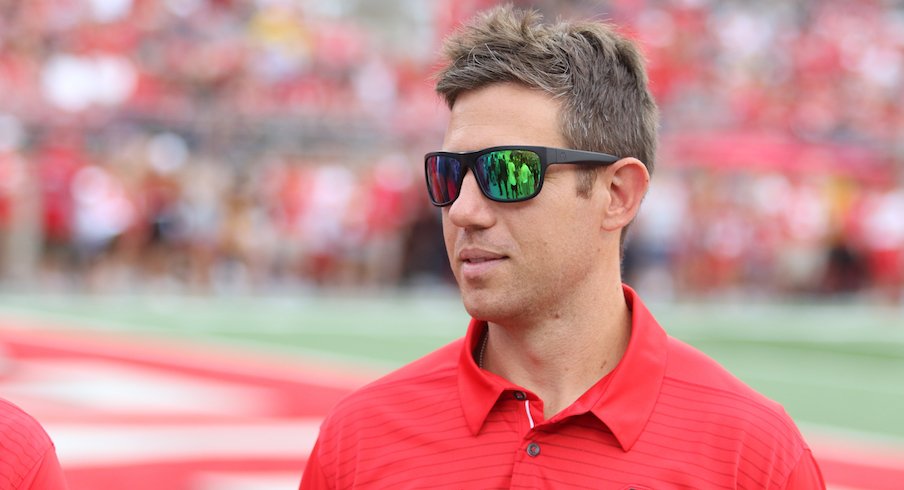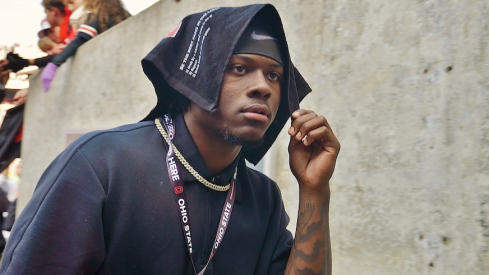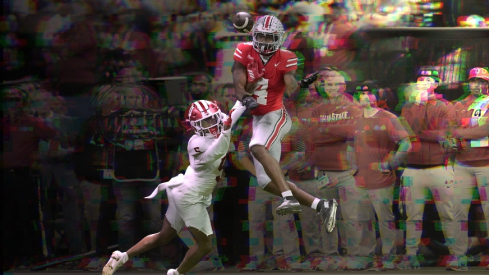Mark Pantoni doesn't give many interviews. But he couldn't turn down Shaun Wade's father, Randy.
Pantoni hopped on the Daddy's Ball Podcast, a show hosted by Randy Wade and Frank Robinson, the father of Alabama cornerback commit Jahquez Robinson, for a half-hour discussion to illuminate the recruiting process at Ohio State. As the assistant athletic director of player personnel, he's in charge of spearheading recruiting for the Buckeyes.
Urban Meyer brought Pantoni with him from Florida, and when he retired, Pantoni remained in Columbus on Ryan Day's staff.
Wade and Robinson have hosted eight episodes of the Daddy's Ball Podcast, and Pantoni was the first person affiliated Ohio State to join the show as a guest. The podcast is designed for the pair of fathers of football players to share what they have learned, and it features interviews with those who can offer insight.
Daddy's Ball Podcast got a full 30 minutes with THE Ohio State's Mark Pantoni Assistant AD/ Player Personnel. Listen in instantly with Podbean Media player Episode 7
— Daddy's Ball Podcast (@podcast_daddy) June 25, 2019
CLICK LINK BELOW:https://t.co/L5o8miLsGv pic.twitter.com/7HmMDtzddq
We put together a list of notes from the podcast with Pantoni, but it's worth listening to the full 30-minute interview.
The Job
- Pantoni said the majority of his job entails evaluating film of high school prospects. But he oversees the entire football recruiting operation, putting him in charge of film evaluation, on-campus visits, compliance, scholarship limitations, maintaining the recruiting board and other day-to-day operations.
- Pantoni: "Really, just making the coaches' lives easier and whatever we can do to help them bring in the best recruits possible."
Getting Noticed
- How does a prospect put himself on Ohio State's radar? Per Pantoni, usually that doesn't happen. Pantoni: "Typically, at a place like Ohio State, where we think we're an elite program, we're more likely going to find you."
- The process of evaluating recruits begins with using recruiting services and position coaches talking to high school coaches to get names of players who could become targets. Then, the film study begins. Usually, coaches begin watching film of players when they're sophomores in high school. The "true evaluation" begins when they can watch tape of junior seasons.
- Since coaches have so much film to watch and short attention spans, they typically watch only one minute of highlight film.
- Pantoni: "So anything that's more than really a minute and a half, two minutes, it's almost kind of worthless to put on there because we're probably going to stop watching it just because we'll have seen probably what we already needed to see. So the first two plays better stick out right away to grab our attention to get us to want to keep watching."
- Tips from Pantoni on highlight film: using circles or arrows before plays to point the player out helps, don't split up offensive and defensive plays into different sections and avoid putting a bunch of pictures and title slides at the beginning.
- The next step in the process? Watching a "minimum" of two full games to see both the good and bad plays.
- Pantoni: "We want to see the true story. I always compare watching a highlight tape to watching a movie trailer. Like, every movie trailer you watch is great. It makes you want to go see that movie, and then you pay that money and the movie sucks. So we're going to put on that game film and see if the game film matches that highlight tape or if there's a lot of inconsistencies, taking plays off."
- If there's interest in a recruit after watching the highlights and games, Pantoni will reach out with a text message or a direct message on Twitter to introduce himself. Then, he passes the player's information to the respective position coach and area recruiter.
Recruiting Board
- At the end of a recruiting class' sophomore year, Pantoni begins to put together an ever-changing recruiting board. It's essentially a list of prospects that ranks the players who are the biggest priorities at each position.
- The board dwindles whenever someone commits to another school or a poor transcript knocks a prospect out of consideration. Prospects get added to the board throughout the years, too, though.
- Among the factors that will affect the placement of recruits on the board: analyzing more film, testing numbers at camps, measurables, grades, how they act on campus visits.
- Depending on the amount of needs, Pantoni said, Ohio State is focused on the top five to 10 recruits at each position.
- Difficult decisions arise when players lower on the recruiting board want to commit, but the staff believes it has a chance with one of the top-rated prospects on the board.
- Pantoni: "Those come down to tough, tough decisions you have to make. And you talk about it as a staff, and ultimately the head coach has got to be the one who makes that decision. But yeah, those types of things happen all the time where a kid you really like may not be your No. 1 guy, but he wants to come and you think he would be a great fit and you have to determine is there a significance difference in the level of that player."
- Head coaches have to rely on the position coaches and Pantoni to aid in those decisions since they have spent significantly more time around the prospects.
Don't Tweet At Recruits
- Ever heard this one before? Well, Pantoni backed it up. He said both recruits and parents have approached him to talk about how fans treat them on social media, sometimes after the prospect names a non-Ohio State team as the leader in his recruitment. Naturally, Pantoni said, fans can "sometimes play a negative impact" in recruiting.
- Pantoni: "And they report it back to us and just say, 'Hey, why would we want to go to a school where the fans are going at us like that?' It's best the fans just kind of lay low, realize you're dealing with kids, and kids got a lot of pressure on them through the recruiting process. Any of that outside recruiting pressure from fans really doesn't help them in their decision."
Family Involvement
- Pantoni compared a recruit taking a visit to Ohio State to a job interview – both parties are evaluating each other.
- Pantoni: "So we're watching the kids and families, how they act, what their demeanor is, how their personalities are. And that, it's not the decision maker, but it could be a decision factor as we're recruiting. Because we want to make sure it's the right culture fit for the kid in the family because we don't want to have an overwhelming parent that's going to call and complain and after a year, their son's going to go in the transfer portal and go back home."
- In Pantoni's mind, the transfer portal is "out of control." Thus, they're looking for the "right culture fit for both the kid and for the family."
- In order to make sure the fit is right, Pantoni said, Ohio State tries to ensure recruits have a complete understanding of the program.
- Pantoni: "Coach Mick (Marotti), as you know, tells every recruit that comes through the weight room, 'Don't come here if you don't want to work because it's not going to be easy.' We try to make them understand how difficult. You've got to win every game at Ohio State. And so the pressure's there, you're playing in front of a huge fan base, and so of course the pressure of these kids to come in and think right away you've got to be the man like in high school. It's a hard reality check sometimes."
- After a someone enrolls, Pantoni said, Ohio State tries to maintain a strong relationship with the parents in order to support their son, which lessens attrition.
- Parents can call assistant coaches and Ryan Day at any time to ask questions about academics, on-field development, the path to graduation or anything else, Pantoni said. Only one topic is off limits: playing time.
- Pantoni: "The one thing that is a sensitive topic, for coaches especially, is the topic of playing time. A lot of times the head coach addresses early on with the parents at least once a year, you call me any time, my door's always open, but I just don't want to hear complaining about playing time because we're going to play the best players regardless. Our job, a big part of it, is to win games. Obviously we're going to make sure that happens for the benefit of an entire team."
Non-Committable Offers
- Dishing out offers, Pantoni said, has "turned into a game" in recent years. "In the past, offers used to mean something, and now they don't."
- Pantoni: "What's happened is you have young kids, say in their sophomore year, and you invite them to camp or you invite them to campus and the kid and his parents say, 'Well, we're not going to pay all that money unless we have an offer.' And so they almost become un-recruitable unless you tell them they've got an offer. And so it's a game you have to play. A lot of people don't like it."
- Some schools, Pantoni said, have offered 300-400 scholarships and only intend to take 25 players in a recruiting class. He said they allow prospects to "play hardball," leveraging their position to receive a scholarship offer.
- Pantoni: "It's what you have to do. But throughout the process, the kids you are very serious about, you just have to be honest with them. Obviously most schools can only take one quarterback in the class, so people realize that spots are limited as well. So not all offers are equal."


